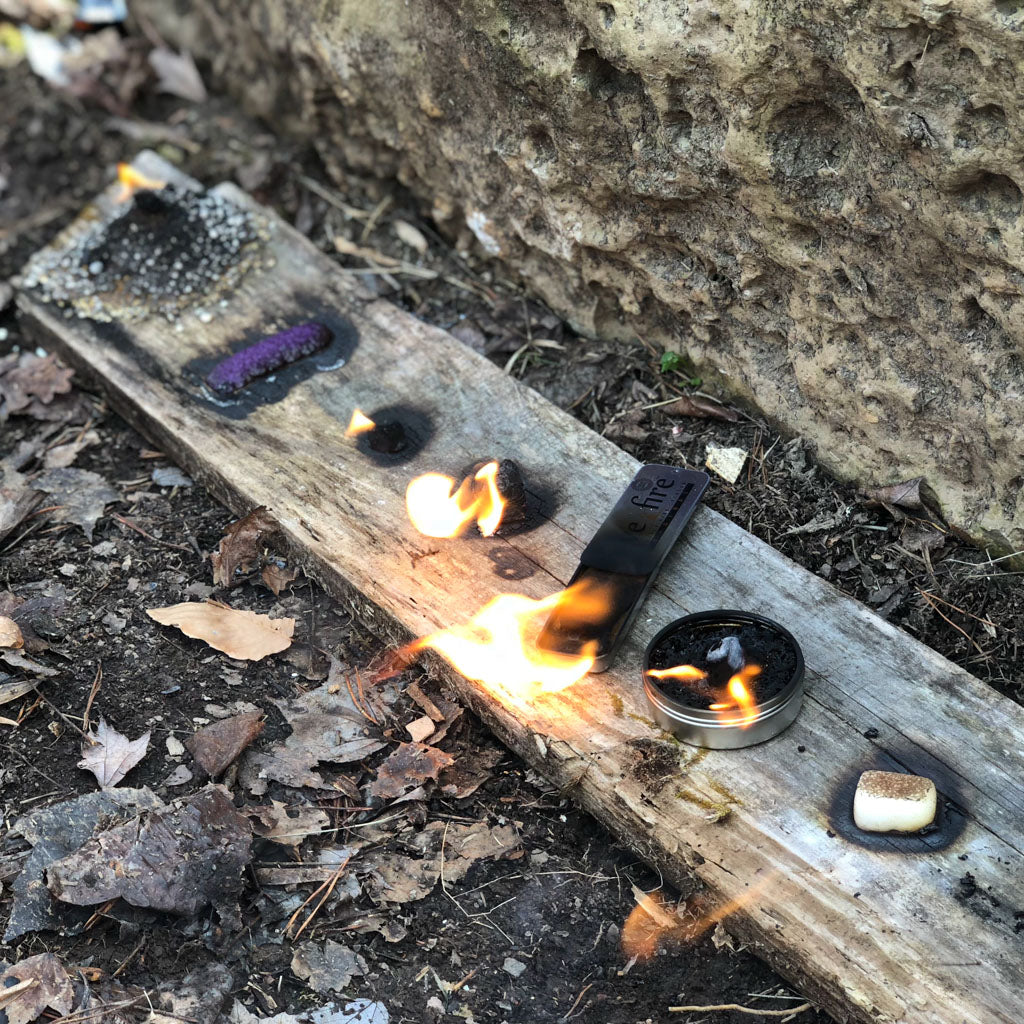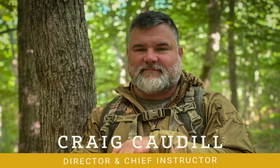
How to make a fire for camping, hiking, backpacking and survival training
Please note: This is another in our continuing series of topics where we dig deep and look at quite a range of details for an individual topic. The blog is detailed and the attached videos are longer than our norm. This is education not entertainment.
Warmth, food prep, and morale are the top three things that will increase in quality with a nice fire in the outdoors. Not to mention, a quality fire might just save your life in a disaster or survival situation. In this piece we wanted to do some testing and review of a few of the most common ignition sources along with, what I like to call fire helpers. Fire helpers are fuel sources made for the sole purpose of making fire. They range in price and usefulness. We see these items in our classes on a regular basis and have never taken the time, until now, to put them head-to-head in testing. We created two videos for you that you can see below. Part 1 details the burn times and ease of igniting, Part 2 will detail the ability of these to work when they are wet.
This topic came to mind recently when the father of an alumni of our school called to thank us for saving his son’s life. It is always humbling to see our students being able to take what we have taught them and utilize it for their own safety and well-being in the outdoors. This young man was on a duck hunting trip in cold weather. He fell out a canoe and was immediately soaked and in danger of going hyopothermic. He put his own good mindset and skills to work so that he came out of the ordeal just fine.
How would you handle yourself in that situation? Getting out of any clothes that do not insulate when wet is my first suggestion. In this piece we are looking directly at firebuilding. Fire building for camping, hiking and other adventure is an integral part of many people’s outdoor time. It works great when the weather is great. The following products can help you when it is not so great outside and you need a little assistance.
- Instafire – this product showed up on Shark Tank and therefore got exposure from that show. It is a package of granules that you pour out and light. You do not have to use the whole package as I did for this video. The bag is not resealable. If you intend on only using a small portion then you will have to plan for that so it does not pour into your pack or similar container.
- Trioxane – these were made initally as US military products for the use in heating C Rations. You can commonly find them in military surplus stores. The byproduct of burning is incredibly determintal to breathe in, so I avoid using them unless I am in completely wide open areas.
- Wetfire – made and distributed by Ultimate Survival Technologies. These are incredibly wide spread in availability and can be found in nearly all outdoor-related stores and big-box stores such as Wal-Mart.
- Fast Fire – before and after I did this test and review I have found Solkoa’s Fast Fire fuel cubes to be my favorite. I think my reasoning why will be apparent after watching the videos and reviewing the chart I have below.
- Live Fire – I have seen these a number of times when students have brought them to class and I finally received one in a Nomadik subscription box they send me for review. I thought they were gimmicky, but after testing them for this endeavor I have a bit more respect for them.
- Uber Fire – I was first introduced to Uber Fire by a friend of mine in a mantracking class. This gentleman is an incredibly well-trained individual after spending a life time in the military doing high-speed, low-drag sorts of work. He was a fan of it and gave me a tin to try out. I have bought several others since that time.
- Esbit – do a cursory google search on these and you will see a multitude of postive comments about them. Which…blows…my….mind. I seriously worry that I am missing something when I see it. They smell terribly bad and well……I will let the videos speak for themselves.
- Cotton Balls and Petroleum Jelly – this review would not be complete without throwing these in there as well. I did not have them in video 1, but did in video 2 to show the reason that I am not a fan. I am not necessarily against them for basic camping, but I would not depend upon them. You will see why in the videos.
In this first video I used both a titanLIGHT from Exotac and some ferrocerium rods from Midwest Woodcraft. My purpose was to see how long each product would burn, get a temperature reading on them and to also see how easy or hard it is to light them with the lighter and the ferro rod. Watch this video and review the chart below for details.
I put this second video together for one purpose only and that was to highlight some ignition sources and fuel sources that had been soaked in water for only a few minutes. This was done to simulate someone falling out of boat, hiking and getting drenched, or some similar situation where their supplies became wet. Please note as I say in the video that the key to each of these is to keep them in their packaging. I take that a step further and keep all of my firemaking supplies in a waterproof container as well.
As for a rundown of all the information presented in the videos, you can reference this chart. Look below the chart for what I carry with me for firestarting. My little setup is simple, inexpensive and has worked for me to make hundreds of fires (which includes resupply). I recently added the Exotac fireSLEEVE to be redundant for keeping my ignition source dry.
| Burn Time (min) | Light w Ferro | Temp | Work wet? | Price forone fire | Notes | |
| Instafire | 18 | Moderate | 280 | no | 0.70 | 2 fires min w each pkg |
| Trioxane | 9 | Easy | 232 | easy | 1.00 | 3 fires per stick |
| Wetfire | 7 | Easy | 220 | easy | 0.69 | 1 fire with each cube |
| Fast Fire | 13 | Easy | 222 | easy | 1.00 | 2 fires min w each cube |
| Live Fire | 14 | Moderate | 218 | moderate | 2.00 | 6 fires with one tin |
| Uber Fire | 18 | Easy | 295 | easy | 1.00 | 30 fires per tin |
| Esbit | 13 | Difficult | 165 | no | 0.74 | 1 fire with each cube |
| Cotton Rolls | 4 | Easy | 160 | no | 0.10 | 1 fire with each roll |
I certainly hope that helps you make good decision on what is best for you to use. Each person’s budget, skill level, and needs are different. You need to find what  works for you. As for me this is what I am currently utilizing as my go-to fire making kit (although I will most likely add the Exotact titanLIGHT to it now that I have one):
works for you. As for me this is what I am currently utilizing as my go-to fire making kit (although I will most likely add the Exotact titanLIGHT to it now that I have one):
- Large Ferrocerium Rod
- Fast Fire cubes
- Jutte twine
- Bic Lighter in Exotact fireSLEEVE
- Magpul waterproof DAKA pouch
 Craig Caudill is the Founder and Chief Instructor of Nature Reliance School. He specializes in teaching outdoor related topics to include, survival, tracking, nature awareness more for private and public groups, and government agencies. Craig’s first book is Extreme Wilderness Survival from Page Street Publishing, distributed by Macmillan Publishing. Craig’s second book, Ultimate Wilderness Gear, is coming in July 2018 and can be pre-ordered now!
Craig Caudill is the Founder and Chief Instructor of Nature Reliance School. He specializes in teaching outdoor related topics to include, survival, tracking, nature awareness more for private and public groups, and government agencies. Craig’s first book is Extreme Wilderness Survival from Page Street Publishing, distributed by Macmillan Publishing. Craig’s second book, Ultimate Wilderness Gear, is coming in July 2018 and can be pre-ordered now!
Craig is a also frequent contributor to TV outlets, blog sites, magazines and is a popular online outdoor educator on his YouTube channel. Pick up the books, subscribe to him on youtube, or join Craig and the other NRS Instructors in a class so they can help you be more safe and aware in the outdoors.


Leave a comment